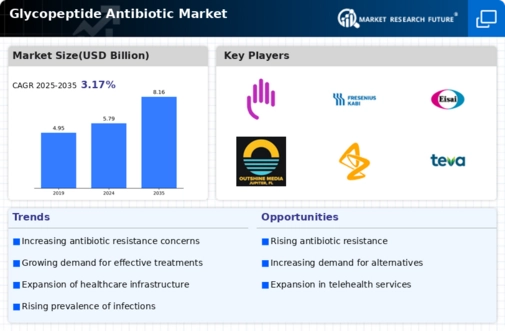Market Growth Projections
The Global Glycopeptide Antibiotic Market Industry is projected to experience substantial growth over the next decade. With a market value expected to reach 5.79 USD Billion in 2024 and 8.16 USD Billion by 2035, the industry is on a promising trajectory. The anticipated CAGR of 3.17% from 2025 to 2035 indicates a steady increase in demand for glycopeptide antibiotics, driven by factors such as rising bacterial infections and advancements in pharmaceutical research. These projections highlight the potential for significant market expansion in the coming years.
Increased Healthcare Expenditure
Rising healthcare expenditure globally is a key driver for the Global Glycopeptide Antibiotic Market Industry. Governments and private sectors are allocating more resources to combat infectious diseases, which includes funding for antibiotic research and development. This increased investment is likely to enhance access to glycopeptide antibiotics, particularly in developing regions where healthcare infrastructure is improving. As healthcare budgets grow, the market is expected to benefit, with a projected CAGR of 3.17% from 2025 to 2035, reflecting the sustained focus on infectious disease management.
Advancements in Pharmaceutical Research
Innovations in pharmaceutical research are propelling the Global Glycopeptide Antibiotic Market Industry forward. The development of novel glycopeptide compounds and formulations is enhancing treatment efficacy and patient outcomes. Research institutions and pharmaceutical companies are investing significantly in R&D to discover new applications for existing antibiotics. This focus on innovation is likely to expand the market, as new products enter the pipeline. The anticipated growth trajectory suggests that by 2035, the market may reach 8.16 USD Billion, driven by these advancements.
Rising Incidence of Bacterial Infections
The Global Glycopeptide Antibiotic Market Industry is experiencing growth due to the increasing prevalence of bacterial infections. Reports indicate that antibiotic-resistant strains are becoming more common, necessitating the use of glycopeptide antibiotics, which are effective against resistant bacteria. For instance, the World Health Organization has highlighted the urgent need for effective treatments as resistance rates climb. This trend is expected to drive the market, with projections indicating that the market could reach 5.79 USD Billion in 2024, reflecting the growing demand for effective antibiotic therapies.
Growing Awareness of Antibiotic Stewardship
The Global Glycopeptide Antibiotic Market Industry is influenced by the increasing awareness of antibiotic stewardship programs. These initiatives aim to optimize the use of antibiotics to combat resistance and improve patient outcomes. Healthcare providers are increasingly adopting guidelines that promote the judicious use of glycopeptide antibiotics, ensuring they are prescribed only when necessary. This awareness is likely to drive demand for effective antibiotics, as practitioners seek to balance efficacy with the need to minimize resistance. Consequently, the market is poised for growth as these programs gain traction.
Regulatory Support for Antibiotic Development
Regulatory bodies are providing support for the development of new antibiotics, including glycopeptides, which is positively impacting the Global Glycopeptide Antibiotic Market Industry. Initiatives aimed at expediting the approval process for new antibiotics are encouraging pharmaceutical companies to invest in research and development. This regulatory environment fosters innovation and could lead to the introduction of new glycopeptide antibiotics in the market. As a result, the industry is likely to see enhanced growth opportunities, contributing to the overall expansion of the market.












